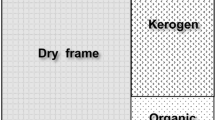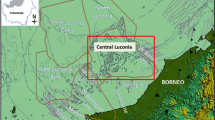Abstract
Sweet spots identification for unconventional shale reservoirs involves detection of organic-rich zones with abundant porosity. However, commonly used elastic attributes, such as P- and S-impedances, often show poor correlations with porosity and organic matter content separately and thus make the seismic characterization of sweet spots challenging. Based on an extensive analysis of worldwide laboratory database of core measurements, we find that P- and S-impedances exhibit much improved linear correlations with the sum of volume fraction of organic matter and porosity than the single parameter of organic matter volume fraction or porosity. Importantly, from the geological perspective, porosity in conjunction with organic matter content is also directly indicative of the total hydrocarbon content of shale resources plays. Consequently, we propose an effective reservoir parameter (ERP), the sum of volume fraction of organic matter and porosity, to bridge the gap between hydrocarbon accumulation and seismic measurements in organic shale reservoirs. ERP acts as the first-order factor in controlling the elastic properties as well as characterizing the hydrocarbon storage capacity of organic shale reservoirs. We also use rock physics modeling to demonstrate why there exists an improved linear correlation between elastic impedances and ERP. A case study in a shale gas reservoir illustrates that seismic-derived ERP can be effectively used to characterize the total gas content in place, which is also confirmed by the production well.



















Similar content being viewed by others
References
Abousleiman Y, Tran M, Hoang S, Bobko C, Ortega A, Ulm F (2007) Geomechanics field and laboratory characterization of the Woodford Shale: the next gas play. SPE paper 110120
Ahmadov R (2011) Microtextural, elastic and transport properties of source rocks. Ph.D. thesis, Stanford University
Alfred D, Vernik L (2012) A new petrophysical model for organic-rich shales. 53rd Annual Logging Symposium, SPWLA, 16–20
Allan AM, Vanorio T, Dahl JEP (2014) Pyrolysis-induced P-wave velocity anisotropy in organic-rich shales. Geophysics 79(2):C73–C88
Bandyopadhyay K (2009) Seismic anisotropy: geological causes and its implications to reservoir geophysics. Ph.D. Thesis, Stanford University
Bandyopadhyay K, Sain R, Liu E, Harris C, Martinez A, Payne M, Zhu Y (2012) Rock property inversion in organic-rich shale: uncertainties, ambiguities, and pitfalls. In: 82nd annual international meeting, SEG, expanded abstracts, pp 1–5
Bello H, Barzola G, Portis D, Tinnin B, Handke M, Clemons K (2013) Multiuse of seismic and attribute mapping for field appraisal and development in the Eagle Ford Shale: mapping TOC, porosity, and seal integrity. In: Unconventional resource technology conference, Denver, Colorado, pp 278–286
Best ME, Katsube TJ (1995) Shale permeability and its significance in hydrocarbon exploration. Lead Edge 14:165–170
Bredesen K, Jensen EH, Johansen TA, Avseth P (2015) Seismic reservoir and source-rock analysis using inverse rock-physics modeling: a Norwegian Sea demonstration. Lead Edge 34(11):1350–1355
Broadhead M, Cheshire SG, Hayton S (2016) The effect of TOC on acoustic impedance for a Middle Eastern source rock. Lead Edge 35(3):258–264
Buland A, Omre H (2003) Bayesian linearized AVO inversion. Geophysics 68(1):185–198
Ciz R, Shapiro S (2007) Generalization of Gassmann equations for porous media saturated with a solid material. Geophysics 72(6):A75–A79
Davie M, Zhu Y, Rehkopf O, Bandyopadhyay K (2012) Characterization of shale gas reservoirs using seismic and well data at Horn River, Canada. In: 82nd annual international meeting, SEG, expanded abstracts, pp 1–5
Gasparik M, Bertier P, Gensterblum Y, Ghanizadeh A, Krooss BM, Littke R (2014) Geological controls on the methane storage capacity in organic-rich shales. Int J Coal Geol 123:34–51
Guo T (2015) The Fuling Shale gas field—a highly productive Silurian gas shale with high thermal maturity and complex evolution history, southeastern Sichuan Basin, China. Interpretation 3(2):SJ25–SJ34
Hart BS, Macquaker J, Taylor KG (2013) Mudstone (“shale”) depositional and diagenetic processes: implications for seismic analyses of source-rock reservoirs. Interpretation 1(1):B7–B26
Hornby BE, Schwartz LM, Hudson JA (1994) Anisotropic effective-medium modeling of the elastic properties of shales. Geophysics 59:1570–1583
Hu R, Vernik L, Nayvelt L, Dicman A (2015) Seismic inversion for organic richness and fracture gradient in unconventional reservoirs: Eagle Ford Shale, Texas. Lead Edge 34(1):80–82, 84
Jarvie D (2004) Evaluation of hydrocarbon generation and storage in Barnett Shale, Fort Worth Basin, Texas. The University of Texas at Austin, Bureau of Economic Geology/PTTC 116
Jiang M, Spikes KT (2013) Estimation of reservoir properties of the Haynesville Shale by using rock-physics modelling and grid searching. Geophys J Int 195(1):315–329
Jiang Z, Tang X, Cheng L, Li Z, Zhang Y, Bai Y, Yuan Y, Hao J (2015) Characterization and origin of the Silurian Wufeng–Longmaxi Formation shale multiscale heterogeneity in southeastern Sichuan Basin, China. Interpretation 3(2):SJ61–SJ74
Johnston JE, Christensen NI (1995) Seismic anisotropy of shales. J Geophys Res 100:5991–6003
Loucks RG, Reed RM, Ruppel SC, Jarvie DM (2009) Morphology, genesis, and distribution of nanometer-scale pores in siliceous mudstones of the Mississippian Barnett shale. J Sediment Res 79:848–886
Loucks RG, Reed RM, Ruppel SC, Hammes U (2012) Spectrum of pore types and networks in mudrocks and a descriptive classification for matrix-related mudrock pores. AAPG Bull 96:1071–1098
Lucier AM, Hofmann R, Bryndzia LT (2011) Evaluation of variable gas saturation on acoustic log data from the Haynesville Shale gas play, NW Louisiana, USA. Lead Edge 30:300–311
Milliken KL, Rudnicki M, Awwiller DN, Zhang T (2013) Organic matter-hosted pore system, Marcellus Formation (Devonian), Pennsylvania. AAPG Bull 97(2):177–200
Modica CJ, Lapierre SG (2012) Estimation of kerogen porosity in source rocks as a function of thermal transformation: example from the Mowry Shale in the Powder River Basin of Wyoming. AAPG Bull 96:87–108
Moyano B, Spikes K, Johansen T, Mondol N (2012) Modeling compaction effects on the elastic properties of clay–water composites. Geophysics 77(5):D171–D183
Ogiesoba O, Hammes U (2014) Seismic-attribute identification of brittle and TOC-rich zones within the Eagle Ford Shale, Dimmit County, South Texas. J Pet Explor Prod Technol 4:133–151
Okiongbo KR, Aplin AC, Larter SR (2005) Changes in type II kerogen density as a function of maturity: evidence from the Kimmeridge clay formation. Energy Fuels 19:2495–2499
Ouadfeul S, Aliouane L (2016) Total organic carbon estimation in shale-gas reservoirs using seismic genetic inversion with an example from the Barnett Shale. Lead Edge 35(9):790–794
Ougier-Simonin A, Renard F, Boehm C, Vidal-Gilbert S (2016) Microfracturing and microporosity in shales. Earth Sci Rev 162:198–226
Passey QR, Bohacs KM, Esch WL, Klimentidis R, Sinha S (2010) From oil-prone source rock to gas-producing shale reservoir—geologic and petrophysical characterization of unconventional shale-gas reservoirs. Presented at the SPE, Paper 131350
Prasad M (2012) Shales and imposters: understanding shales, organics, and self-resourcing rocks. Fall 2012 SEG/AAPG Distinguished Lecturer
Qin X, Han DH, Zhao L (2014) Rock physics modeling of organic-rich shales with different maturity levels. In: 84th annual international meeting, SEG, expanded abstracts, pp 2952–2957
Ross DJK, Bustin RM (2009) The importance of shale composition and pore structure upon storage potential of shale gas reservoirs. Mar Pet Geol 26:916–927
Sayers CM, Guo S, Silva J (2015) Sensitivity of the elastic anisotropy and seismic reflection amplitude of the Eagle Ford Shale to the presence of kerogen. Geophys Prospect 63:151–165
Shitrit O, Hatzor YH, Feinstein S, Palchik V, Vinegar HJ (2016) Effect of kerogen on rock physics of immature organic-rich chalks. Mar Pet Geol 73:392–404
Sone H (2012) Mechanical properties of shale gas reservoir rocks and its relation to the in situ stress variation observed in shale gas reservoirs. Ph.D. thesis, Stanford University
Sone H, Zoback MD (2013) Mechanical properties of shale gas reservoir rocks—part 1: static and dynamic elastic properties and anisotropy. Geophysics 78(5):D381–D392
Talu O, Myers AL (2001) Reference potentials for adsorption of helium, argon, methane, and krypton in high-silica zeolites. Colloids Surf A 187–188:83–93
Thomsen L (1986) Weak elastic anisotropy. Geophysics 51(10):1954–1966
Verma S, Roy A, Perez R, Marfurt KJ (2012) Mapping high frackability and high TOC zones in the Barnett Shale: supervised probabilistic neural network vs. unsupervised multi-attribute Kohonen SOM. In: 82nd annual international meeting, SEG, expanded abstracts, pp 1–4
Vernik L (1993) Microcrack-induced versus intrinsic elastic anisotropy in mature HC-source shales. Geophysics 58:1703–1706
Vernik L, Landis C (1996) Elastic anisotropy of source rocks: implications for hydrocarbon generation and primary migration. AAPG Bull 80:531–544
Vernik L, Liu X (1997) Velocity anisotropy in shales: a petrophysical study. Geophysics 62:521–532
Vernik L, Milovac J (2011) Rock physics of organic shales. Lead Edge 30:318–323
Wang Z (2002) Seismic anisotropy in sedimentary rocks, part 1: a single-plug laboratory method. Geophysics 67(5):1415–1422
Wang FP, Reed RM (2009) Pore networks and fluid flow in Gas Shales. Society of Petroleum Engineers, Paper No. SPE-124253, 8
Wu X, Uden R, Chapman M (2016) Shale anisotropic elastic modelling and seismic reflections. J Seism Explor 25(6):527–542
Yenugu M (2014) Elastic, microstructural and geochemical characterization of kerogen maturity for shales. Ph.D. dissertation, University of Houston
Yew CH, Weng X (2015) Mechanics of hydraulic fracturing, 2nd edn. Gulf, Houston
Zargari S, Prasad M, Mba KC, Mattson ED (2013) Organic maturity, elastic properties and textural characteristics of self resourcing reservoirs. Geophysics 78(4):D223–D235
Zargari S, Wilkinson TM, Parckar CE, Prasad M (2016) Effect of thermal maturity on elastic properties of kerogen. Geophysics 81:M1–M6
Zhang T, Ellis GS, Ruppel SC, Milliken K, Yang R (2012) Effect of organic-matter type and thermal maturity on methane adsorption in shale-gas systems. Org Geochem 47:120–131
Zhao L, Geng J, Cheng J, Han D, Guo T (2014) Probabilistic lithofacies prediction from prestack seismic data in a heterogeneous carbonate reservoir. Geophysics 79(5):M25–M34
Zhao L, Qin X, Han D, Geng J, Yang Z, Cao H (2016) Rock-physics modeling for the elastic properties of organic shale at different maturity stages. Geophysics 81(5):D527–D541
Zhu Y, Liu E, Martinez A, Payne MA, Harris CE (2011) Understanding geophysical responses of shale-gas plays. Lead Edge 30:332–338
Acknowledgements
This work was supported by the Strategic Priority Research Program of the Chinese Academy of Sciences (Grant No. XDA14010203), Fluids and DHI consortium of the Colorado School of Mines and University of Houston, the Foundation of State Key Laboratory of Shale Oil and Gas Enrichment Mechanisms and Effective Development, National Natural Science Foundation of China (Grant No. 41504087), and Innovative Program of Shanghai Municipal Education Commission. We thank SINOPEC for permission to show the well-logging and seismic data. The database for this paper is available by contacting the corresponding author at zhaoluanxiao@tongji.edu.cn.
Author information
Authors and Affiliations
Corresponding author
Appendices
Appendix 1
See Table 4.
Appendix 2
See Table 5.
Rights and permissions
About this article
Cite this article
Zhao, L., Qin, X., Zhang, J. et al. An Effective Reservoir Parameter for Seismic Characterization of Organic Shale Reservoir. Surv Geophys 39, 509–541 (2018). https://doi.org/10.1007/s10712-017-9456-9
Received:
Accepted:
Published:
Issue Date:
DOI: https://doi.org/10.1007/s10712-017-9456-9




